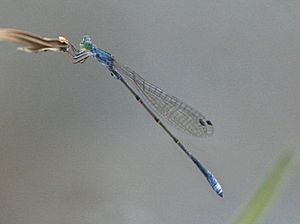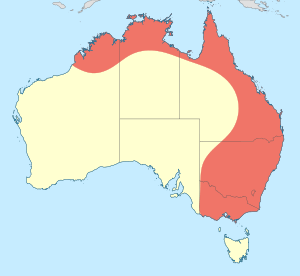Rhadinosticta facts for kids
Quick facts for kids Rhadinosticta |
|
|---|---|
 |
|
| Rhadinosticta banksi | |
| Scientific classification |
|
| Kingdom: | Animalia |
| Phylum: | Arthropoda |
| Class: | Insecta |
| Order: | Odonata |
| Suborder: | Zygoptera |
| Family: | Isostictidae |
| Genus: | Rhadinosticta Watson, 1991 |
 |
|
Rhadinosticta is a genus of damselfly. Think of a genus as a group of very similar animals. These damselflies belong to the family called Isostictidae.
These special damselflies are endemic to eastern Australia. This means they are found only in that part of the world and nowhere else naturally. Rhadinosticta damselflies are usually slim and medium-sized. They often have a dull color, which helps them blend in with their surroundings.
Contents
What are Rhadinosticta Damselflies?
Damselflies are insects that look a lot like dragonflies. They are part of a larger group called Odonata. Damselflies usually hold their wings together over their back when they are resting. Dragonflies, on the other hand, hold their wings out to the sides.
Rhadinosticta damselflies were first described by a scientist named Watson in 1991. They are an important part of the Australian ecosystem.
Types of Rhadinosticta Damselflies
The genus Rhadinosticta includes several different species. Each species has its own unique features. Here are some of the known species:
- Rhadinosticta banksi (Tillyard, 1913) – This one is also known as the Northern wiretail.
- Rhadinosticta handschini (Lieftinck, 1933)
- Rhadinosticta simplex (Martin, 1901) – This species is sometimes called the Powdered wiretail.
Scientists give these damselflies special names to help tell them apart. The names often include who first described them and when.
Where do Rhadinosticta Damselflies Live?
As mentioned, Rhadinosticta damselflies live only in eastern Australia. They prefer habitats near water. This includes places like streams, rivers, and ponds. They need water for their life cycle, especially when they are young.
The map in the infobox shows the areas where these damselflies can be found. Protecting their watery homes is important for their survival.
See also
 In Spanish: Rhadinosticta para niños
In Spanish: Rhadinosticta para niños

